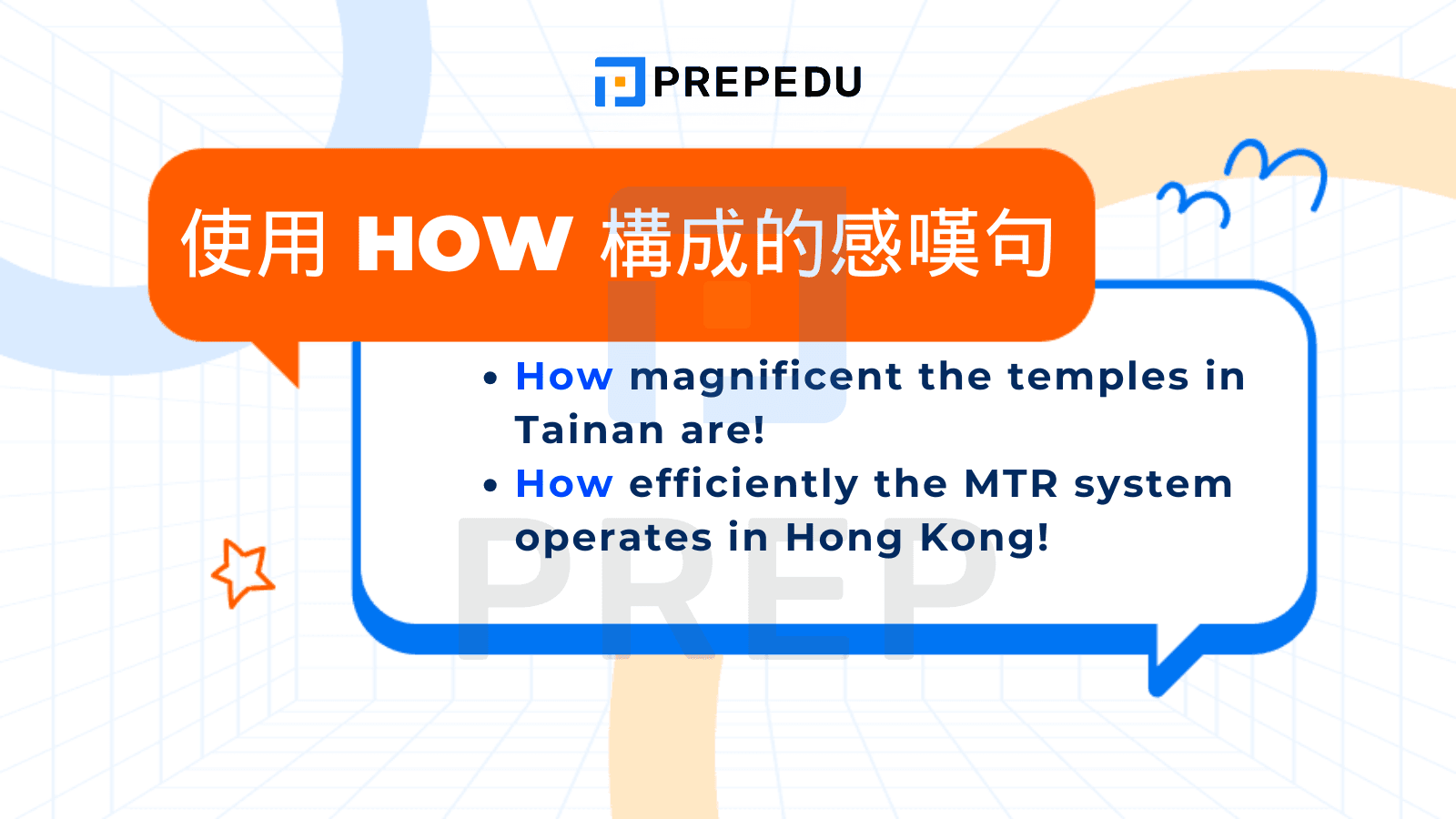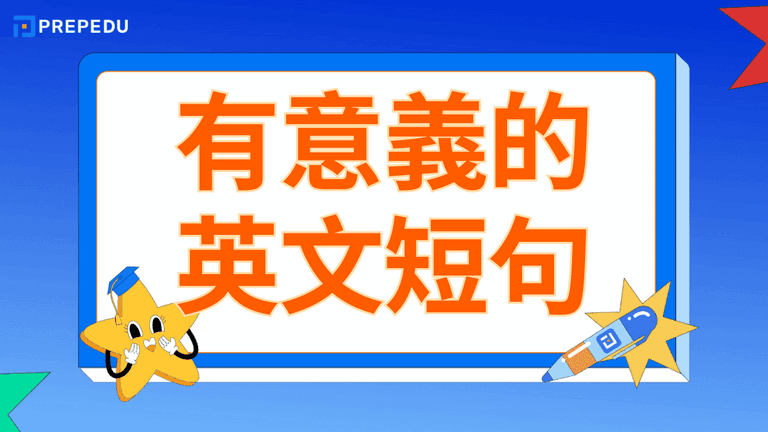感嘆句英文用法全解析:What 與 How 句型,文法與練習題
什麼是感嘆句英文?如何正確使用 What 和 How 表達強烈情感?感嘆句英文(Exclamatory Sentence)是專門用於表達驚訝,喜悅,憤怒等強烈情緒的句型,必須在句尾使用驚嘆號(!)。最常見的兩種結構是 What 感嘆句(強調名詞)和 How 感嘆句(強調形容詞或副詞)。例如當你看到台北101的美景時,可以說「What a breathtaking view!」或「How beautiful it is!」來表達讚嘆。掌握感嘆句不僅能讓你的英語表達更生動自然,更是 IELTS,TOEIC 等英語考試的重要文法考點。
許多台灣和香港的英語學習者經常混淆 What 和 How 的使用時機,或是忘記在單數可數名詞前加上冠詞 a/an。根據 PREPEDU 多年的教學經驗,這些錯誤源於對句型結構的理解不夠透徹。事實上,只要記住「What 後接名詞,How 後接形容詞/副詞」的核心原則,就能輕鬆分辨使用場合。
本文將為你完整解析感嘆句的五大類型,What 與 How 的區別,So/Such 等進階用法,並提供30道實戰練習題(附完整解答)。無論你是準備英語檢定考試,或想提升日常會話能力,這篇由 PREP 專業團隊編寫的指南都能幫助你全面掌握感嘆句的正確用法。

I. 感嘆句英文(Exclamatory Sentence)的定義與功能
感嘆句英文稱為 Exclamatory Sentence,是用於表達強烈情緒反應的特殊句型。當你想要表達喜悅,驚訝,憤怒,悲傷或其他激烈情感時,感嘆句就是最適合的表達方式。這種句型不僅在日常對話中頻繁出現,在文學作品和演說中也扮演著重要角色。掌握感嘆句用法能讓你的英語表達更生動、更貼近母語者的自然語感。
感嘆句英文有一個不可或缺的特徵:句尾必須使用驚嘆號(!)。沒有驚嘆號的句子,無論語氣多強烈,都不能稱為感嘆句。這個標點符號英文傳達了說話者的情緒強度,讓讀者或聽者立刻感受到表達的力度。與平淡的陳述句「That's good.」相比,「This is fantastic!」的感嘆句能夠立即將情緒傳達給對方。
需要注意的是,在正式文件如商業信函,報告或合約中,應該避免過度使用感嘆句。過多的感嘆句會削弱情緒表達的效果,反而讓內容顯得不夠嚴謹。掌握適當的使用時機,才能讓感嘆句發揮最大功效。
II. 感嘆句英文有哪些?完整句型結構解析
感嘆句英文有多種構成方式,每種方式都有其特定的使用情境和文法規則。理解這些不同類型能幫助你在各種場合準確表達情感。
1. 使用感嘆句英文構成的感嘆句
這是最簡單也最常見的感嘆句英文形式,只需在感嘆詞後加上驚嘆號即可。感嘆詞如 Wow,Oh,Alas,Hurray 等能迅速傳達情緒,不需要完整的句子結構就能讓對方理解你的感受。
感嘆句例子:
-
Wow! This chicken cutlet is huge!(哇!這塊雞排好大!)
-
Oh my! The fireworks are spectacular!(天啊!煙火太壯觀了!)

2. 使用 What 構成的感嘆句(強調名詞)
What 感嘆句英文的核心功能是強調「名詞英文」,當你想突顯某個人,事物的特質時,這個句型最為適合。根據名詞的性質,What 句型分為三種主要結構。
|
構造 |
說明 |
例句 |
|
What + a/an + 形容詞 + 單數可數名詞(+ 主詞 + 動詞)! |
這是最常用的 What 感嘆句型,用於單數可數名詞。冠詞 a/an 的選擇完全取決於後方形容詞英文的「發音」,而非字母拼寫。 |
|
|
What + 形容詞 + 複數可數名詞(+ 主詞 + 動詞)! |
當名詞為複數時不使用 a/an,但形容詞依然必須放在名詞前。如果句中有動詞英文,則必須使用複數形式的 be 動詞(are/were)。 |
|
|
What + 形容詞 + 不可數名詞(+ 主詞 + 動詞)! |
不可數名詞如 water、advice、information 等,前面不能加 a/an,也不能變成複數。 |
|

3. 使用 How 構成的感嘆句英文(強調形容詞/副詞)
How 與 What 感嘆句的區別是英文學習者最常詢問的問題。How 專門用於強調「形容詞或副詞英文的程度」,而不直接涉及名詞。這種結構更簡潔,在口語中使用頻率極高。
結構:
How + 形容詞/副詞(+ 主詞 + 動詞)!
感嘆句例子:
-
How magnificent the temples in Tainan are!(台南的廟宇多麼壯麗!)
-
How efficiently the MTR system operates in Hong Kong!(香港的地鐵系統運作得多麼有效率!)
關鍵錯誤警示:How 後面「絕對不能」直接接名詞片語。例如「How a good student」是完全錯誤的,正確應該是「What a good student」或「How good the student is」(這個學生多麼好啊!)。

4. 直接在陳述句句尾加驚嘆號
任何陳述句只要在句尾加上驚嘆號,就能成為感嘆句英文。這種方式最靈活,但要注意語境必須支持情緒表達,否則會讓讀者感到困惑。
例句:
-
I just caught the last MRT train in Taipei!(我剛好趕上台北捷運末班車!)
-
She got the job offer in Hong Kong!(她獲得香港的工作機會了!)

5. 使用 Such 構成的感嘆句
Such 感嘆句英文來自於陳述句的轉換,例如「It is such a wonderful day」可以簡化為「Such a wonderful day!」(這真是多麼美好的一天!)。這種形式在文學作品中較常見,口語中相對較少使用。
結構:
Such +(a/an)+ 形容詞 + 名詞!
例句:
-
Such a clear starry night in Taitung!(台東的星空如此清澈!)
-
Such friendly service at the Hong Kong restaurant!(香港餐廳的服務如此友善!)

III. 感嘆句 What How 的区别?核心差異與轉換技巧
感嘆句英文中,How What 感嘆句的選擇是學習者最大的挑戰之一。掌握它們的核心差異,你就能在任何情況下正確使用感嘆句。
看句子的「重心」落在哪裡:如果你想強調的是「名詞本身」(如一個人,一件事物),用 What;如果想強調的是「形容詞或副詞的程度」(如多美,多快),用 How:
-
想說「多麼美的花」→ 重心在「花」這個名詞 → 用 What
-
想說「這花多美」→ 重心在「美」這個形容詞 → 用 How
|
比較維度 |
What 感嘆句 |
How 感嘆句 |
|
強調對象 |
名詞(人,事,物) |
形容詞/副詞(性質,程度) |
|
結構複雜度 |
較長,包含完整名詞片語 |
較短,直接表達程度 |
|
必須元素 |
名詞不可省略 |
形容詞/副詞不可省略 |
|
冠詞使用 |
單數可數名詞必須有 a/an |
不使用冠詞 |
|
口語使用頻率 |
中等 |
高(更自然,更簡潔) |
|
例句 |
|
|
許多句子可以在 What 和 How 之間轉換,但要注意兩者的語氣和重點略有不同。轉換步驟:
|
從陳述句到 What 感嘆句英文 |
從陳述句到 How 感嘆句英文 |
|
|
實例示範:
原句:The student from Taipei is very diligent.(這位來自台北的學生非常勤奮。)
-
轉換為 What:What a diligent student from Taipei!(來自台北的學生多麼勤奮!)
-
轉換為 How:How diligent the student from Taipei is!(這位來自台北的學生多麼勤奮!)
兩種表達都正確,但 What 突出「學生」這個身分,How 則更強調「勤奮」的程度。
特殊情況說明:
|
只能用 What 的情況 |
只能用 How 的情況 |
|
|
IV. 進階感嘆句英文型:So,Such 與其他表達方式
感嘆句英文除了 What 和 How,還有多種進階句型能夠表達強烈情感。這些用法在日常口語中甚至比標準感嘆句更常見,掌握它們能讓你的英語表達更接近母語者的習慣。
1. So 與 Such 的用法與差異
So 和 Such 都表示「如此,這麼」的意思,但它們的文法功能完全不同。So 是副詞,修飾形容詞或副詞;Such 是限定詞,修飾名詞片語。這個區別決定了它們在句中的位置和搭配方式。
|
構造 |
說明 |
例句 |
|
|
So 的句型結構 |
主詞 + 動詞 + so + 形容詞/副詞! |
So 後面「永遠」接形容詞或副詞,表達程度之強烈。這種句型在口語中極為普遍,語氣比 How 感嘆句英文更加自然隨意。 |
|
|
So... that 句型 |
So + 形容詞/副詞 + that + 結果子句 |
當要描述「太...以致於...」時 |
|
|
Such 的句型結構 |
主詞 + 動詞 + such +(a/an)+ 形容詞 + 名詞! |
Such 修飾整個名詞片語,強調名詞的特質。注意單數可數名詞前要加 a/an,複數和不可數名詞則不需要。 |
|
|
Such... that 句型 |
主語 + 動詞 + such + (a/an) + 形容詞 + 名詞 + that + 結果子句 |
Such 也可以搭配 that 子句表達因果關係。 |
|
2. 否定疑問句式感嘆句
否定疑問句形式的感嘆句英文帶有強烈的反詰語氣,常用於表達驚訝,不滿或強調肯定的意思。雖然形式是疑問句,但實際上是在加強肯定的語氣。
結構:
Isn't/Aren't/Wasn't/Weren't + 主詞 + 形容詞!
例句:
-
Isn't the sunrise at Alishan breathtaking!(阿里山的日出難道不令人驚嘆嗎!)➡️ 意指真的很驚嘆
-
Aren't the New Year fireworks in Hong Kong spectacular!(香港的跨年煙火難道不壯觀嗎!)➡️ 意指真的很壯觀
使用時機:這種句型特別適合當你想表達「這難道不是很明顯嗎?」的語氣,帶有一種「不是嗎?」的確認意味。
3. 簡略式感嘆句
簡略感嘆句英文省略了主詞和動詞,只保留最核心的感嘆部分。這種形式在口語中極為常見,特別適合表達突發的情緒反應。
常見簡略形式:
|
完整句型 |
簡略形式 |
情境 |
|
What a mess this room is! |
What a mess!(真是一團糟!) |
小王看到台北宿舍的房間 |
|
How wonderful this is! |
How wonderful!(太棒了!) |
小美收到香港大學的錄取通知 |
|
What a pity it is! |
What a pity!(真可惜!) |
小王錯過台中歌劇院的表演 |
|
How amazing! |
Amazing!(太神奇了!) |
小美看到香港的摩天大樓 |
省略原則:當上下文已經清楚表明說話對象時,主詞和動詞可以省略。但要確保省略後意思仍然明確。
4. 使用形容詞當感嘆詞
某些強烈的形容詞如 Fantastic(棒極了),Incredible(難以置信),Amazing(驚人),Brilliant(出色)可以直接作為感嘆詞使用,功能類似於 Wow。這些詞傳達的情緒更具體,比單純的感嘆詞更有層次。
|
形容詞感嘆詞 |
表達情緒 |
情境例句 |
|
Fantastic! |
讚賞,興奮 |
Fantastic! Xiaowang got the scholarship to study in Taipei!(太棒了!小王獲得在台北讀書的獎學金!) |
|
Incredible! |
難以置信,驚訝 |
Incredible! She climbed up Lion Rock in Hong Kong!(不可思議!她爬上香港獅子山了!) |
|
Brilliant! |
聰明,出色(英式英語常用) |
Brilliant! You solved this math problem from the Taiwanese exam!(太棒了!你解出這道台灣考試的數學題!) |
|
Awful! |
糟糕,厭惡 |
Awful! The typhoon hit Taipei last night!(太糟了!昨晚颱風襲擊台北!) |
V. 英语感叹词有哪些?完整分類與使用指南
感嘆詞(Interjections)與感嘆句英文(Exclamatory Sentences)是不同的概念。感嘆詞是單一詞彙,可以獨立使用,無需完整句子結構就能表達情緒;感嘆句英文則是完整的句子,有主詞,動詞等文法成分。兩者都能表達情感,但文法地位和使用方式完全不同。
感嘆句英文中,感嘆詞扮演著快速傳遞情緒的角色。掌握各類感嘆詞能讓你的反應更自然,更貼近母語者的表達習慣。
|
情緒類型 |
感嘆詞 |
使用情境 |
例句 |
|
喜悅讚美 |
Wow |
強烈驚喜 |
Wow! The night view from Taipei 101 is stunning!(哇!從台北101看到的夜景好驚人!) |
|
Fantastic |
高度讚賞 |
Fantastic! You passed the IELTS exam!(太棒了!你通過雅思考試了!) |
|
|
Bravo |
熱烈讚賞 |
Bravo! The performance at the Hong Kong Arts Festival!(好極了!香港藝術節的表演!) |
|
|
Hooray/ Hurray |
歡呼雀躍 |
Hooray! We won the game!(萬歲!我們贏了!) |
|
|
驚訝 |
Oh |
輕度驚訝 |
Oh! I didn't know you were in Hong Kong!(喔!我不知道你在香港!) |
|
Oh my God |
強烈驚訝 |
Oh my God! The typhoon caused flooding in Taipei!(我的天!颱風造成台北淹水!) |
|
|
Wow |
正面驚訝 |
Wow! You got promoted already?(哇!你已經升職了?) |
|
|
Amazing |
讚嘆驚訝 |
Amazing! You learned Mandarin in six months!(太驚人了!你六個月就學會中文!) |
|
|
痛苦厭惡 |
Ouch |
身體疼痛 |
Ouch! I burned my hand!(痛!我燙到手了!) |
|
Yuck/ Ew |
厭惡 |
Yuck! This milk has gone bad!(噁!這牛奶壞掉了!) |
|
|
Oops |
犯錯失誤 |
Oops! I took the wrong MTR line!(糟糕!我搭錯地鐵線了!) |
|
|
肯定回應 |
Yeah |
同意 |
Yeah! I agree that Taipei has great food!(對啊!我同意台北有很棒的美食!) |
|
Exactly |
完全正確 |
Exactly! That's what I meant!(沒錯!我就是這個意思!) |
|
|
Absolutely |
絕對同意 |
Absolutely! Hong Kong is a financial hub!(絕對是!香港是金融中心!) |
|
|
Bingo |
答對了 |
Bingo! You guessed the correct answer!(賓果!你猜對答案了!) |
|
|
問候告別 |
Hello/Hi |
問候 |
Hi! Welcome to Taipei!(嗨!歡迎來到台北!) |
|
Hey |
非正式問候 |
Hey! Long time no see!(嘿!好久不見!) |
|
|
Bye/ Goodbye |
告別 |
Goodbye! See you next month!(再見!下個月見!) |
|
|
猶豫思考 |
Hmm/Um |
思考中 |
Hmm... I'm not sure which restaurant is better.(嗯...我不確定哪家餐廳比較好。) |
|
Well |
緩衝轉折 |
Well, let me think about it.(這個嘛,讓我想一想。) |
|
|
Let me see |
考慮中 |
Let me see... When can we meet?(讓我想想...我們什麼時候可以見面?) |
VI. 感嘆句文法練習題(附完整解答)
透過系統性的練習能夠鞏固你對感嘆句英文的理解和應用能力。以下三組練習涵蓋選填,改寫和翻譯等台灣和香港考試常見題型。完成練習後請仔細核對答案,並閱讀解析以理解每題的文法重點。
1. 練習一:What 與 How 選填
請根據句子結構,在空格處填入 What 或 How,使感嘆句英文完整且正確。記住判斷原則:後接名詞用 What,後接形容詞或副詞用 How。
題目:
-
_____ a magnificent temple Longshan Temple in Taipei is!
-
_____ efficiently the Hong Kong MTR operates!
-
_____ delicious bubble tea Xiaowang bought in Taichung!
-
_____ breathtaking the view from Victoria Peak is!
-
_____ an expensive smartphone she purchased in Taipei!
-
_____ carefully the chef prepared the dim sum in Hong Kong!
-
_____ a talented musician he met at the Taipei Music Festival!
-
_____ humid the weather in Taiwan is during summer!
-
_____ amazing street performances they saw in Ximending!
-
_____ quickly time flies when you're exploring Hong Kong!
解答與詳解:
-
What(後接名詞片語「a magnificent temple」,且 Longshan Temple 是補充說明)➡️ 完整句:What a magnificent temple Longshan Temple in Taipei is!(台北龍山寺是多麼宏偉的寺廟!)
-
How(後接副詞「efficiently」,描述 MTR 運作的方式)➡️ 完整句:How efficiently the Hong Kong MTR operates!(香港地鐵運作得多有效率!)
-
What(後接形容詞「delicious」+ 名詞「bubble tea」,且 bubble tea 是不可數名詞,無需 a/an)➡️ 完整句:What delicious bubble tea Xiaowang bought in Taichung!(小王在台中買的珍珠奶茶多美味!)
-
How(後接形容詞「breathtaking」,描述景色的程度)➡️ 完整句:How breathtaking the view from Victoria Peak is!(從太平山看到的景色多麼令人驚嘆!)
-
What(後接名詞片語「an expensive smartphone」,expensive 以母音發音開頭用 an)➡️ 完整句:What an expensive smartphone she purchased in Taipei!(她在台北買的智慧型手機多貴!)
-
How(後接副詞「carefully」,描述廚師準備點心的方式)➡️ 完整句:How carefully the chef prepared the dim sum in Hong Kong!(廚師在香港準備點心多仔細!)
-
What(後接名詞片語「a talented musician」)➡️ 完整句:What a talented musician he met at the Taipei Music Festival!(他在台北音樂節遇到的音樂家多有才華!)
-
How(後接形容詞「humid」,描述天氣的程度)➡️ 完整句:How humid the weather in Taiwan is during summer!(台灣夏天的天氣多潮濕!)
-
What(後接形容詞「amazing」+ 名詞「street performances」,複數名詞無需 a/an)➡️ 完整句:What amazing street performances they saw in Ximending!(他們在西門町看到的街頭表演多精彩!)
-
How(後接副詞「quickly」,描述時間流逝的速度)➡️ 完整句:How quickly time flies when you're exploring Hong Kong!(你在探索香港時,時間過得多快!)
2. 練習二:句型改寫與重組
題目:
|
A. 將陳述句改寫為感嘆句(使用 What 或 How) |
B. 重組下列詞語成正確的感嘆句英文 |
|
|
解答:
|
A. 將陳述句改寫為感嘆句(使用 What 或 How) |
B. 重組下列詞語成正確的感嘆句 |
|
|
3. 練習三:進階翻譯與糾錯
題目:
|
A. 將中文翻譯成英文感嘆句 |
B. 找出並改正下列句子的錯誤 |
|
|
解答:
|
A. 將中文翻譯成英文感嘆句 |
B. 找出並改正下列句子的錯誤 |
|
|
結論
透過系統性學習感嘆句英文的各種句型和用法,你現在已經掌握了表達強烈情感的重要文法工具。無論是使用 What 強調名詞,How 強調形容詞副詞,還是運用 So,Such 等進階句型,每種表達方式都有其獨特的語感和使用時機。
記住這些核心原則:What 後接名詞片語,How 後接形容詞或副詞;感嘆句英文必須以驚嘆號結尾;感嘆詞能快速傳達情緒但不應過度使用。多加練習不同情境下的應用,特別是將書面練習轉化為口語表達,你就能在日常對話和寫作中自然運用這些句型。
您是否曾懷疑自己能否達到目標分數?PREPEDU.COM 的 Test Practice 不僅協助您練習考題,更能根據目前成績精準預測達分可能性。
憑藉數千名成功學員的資料庫,系統分析分數趨勢並提供符合各項具體目標的個人化學習路徑。無論您的目標是雅思 6.5 分或多益 850 分,每個目標都有專屬策略。
視覺化進度追蹤功能顯示您目前的位置,以及達成目標還需多長時間。許多學員在持續練習 4-6 週後,雅思成績提升 0.5-1.0 分,多益成績增加 100-200 分。
成功並非來自運氣,而是源於周全的準備。讓 PREP Test Practice 成為連結現在與夢想的橋樑!

你好!我叫黃秋賢。現在在網站 prepedu.com 的部落格擔任產品內容經理。
我有超過5年的英語、韓語等外語自學經驗,並準備過 IELTS、TOEIC、TOPIK 等考試,累積了豐富的實戰知識,也曾協助數千位在語言學習上遇到困難的人。希望以上的分享能幫助大家在家中更有效率地自學!
評論











